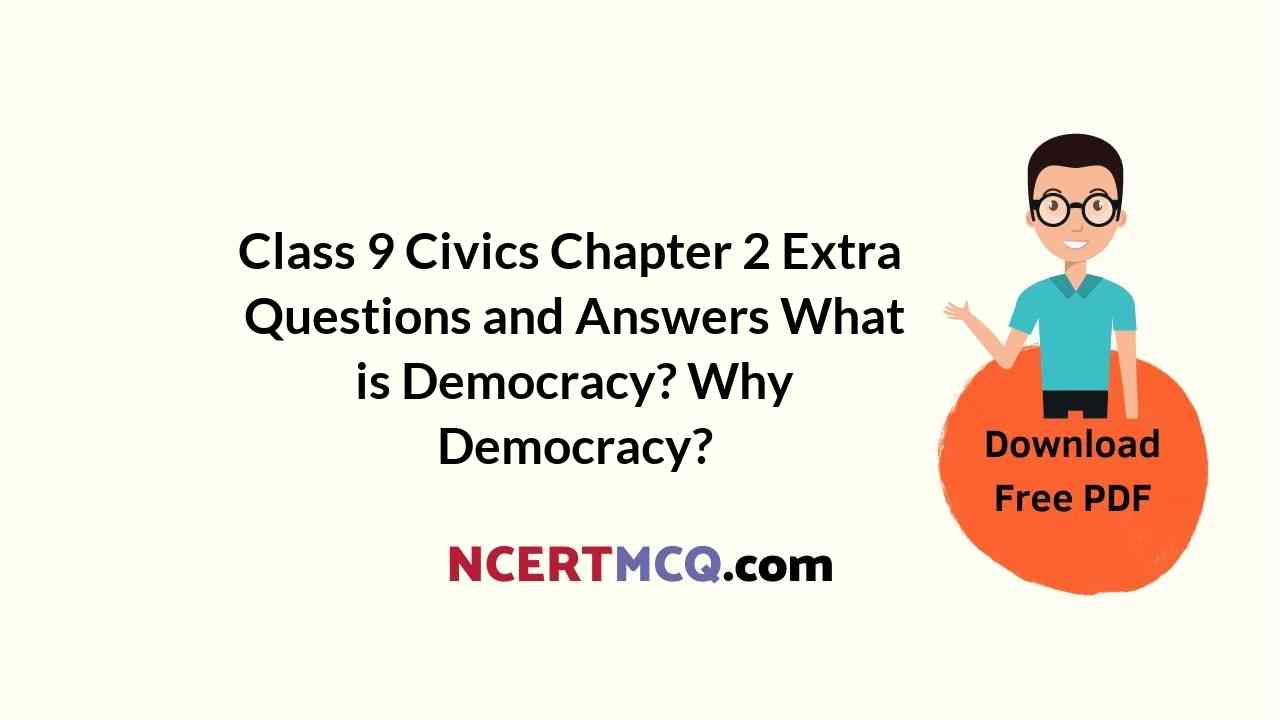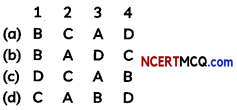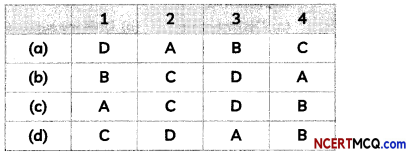Check the below NCERT MCQ Questions for Class 9 Civics Chapter 2 Extra Questions and Answers What is Democracy? Why Democracy? Pdf free download. https://ncertmcq.com/extra-questions-for-class-9-social-science/
What is Democracy? Why Democracy? Class 9 Extra Questions Civics Chapter 2
Class 9 Civics Chapter 2 Extra Questions And Answers Question 1.
To what was Allende’s government committed in Chile?
Answer:
Allende’s government was committed to greater role in economic activities.
Class 9 Civics Chapter 1 Extra Questions And Answers Question 2.
To what was Walesa’s government committed in Poland?
Answer:
Walesa’s government was committed to as little role as was possible.
Extra Questions For Class 9 Civics Chapter 2 What Is Democracy Why Democracy Question 3.
Why do we need a definition?
Answer:
We need a definition when we counter a difficulty in everyday use.
Ncert Solutions For Class 9 Civics Chapter 2 Extra Questions Question 4.
What form of government democracy is?
Answer:
Democracy is a form of government in which the rulers are elected by the people.
Class 9 Civics Chapter 2 Questions And Answers Question 5.
State any one necessary condition of democracy.
Answer:
Election is the necessary condition of democracy.
![]()
Class 9 Civics Ch 2 Extra Questions Question 6.
Do we have election in a monarchy where the king is all-powerful?
Answer:
There can be no election in a monarchy headed by a real powerful king.
Ncert Solutions For Class 9 Civics Chapter 1 Extra Questions Question 7.
Does the army regime permit elections where it rules through the gun?
Answer:
Normally not. The army general may allow election only to legitimate his rule.
Class 9 Civics Chapter 2 Mcqs With Answers Question 8.
From which language the word . democracy has come up?
Answer:
Etymologically, democracy is derived from two Greek words ‘demos’ and ‘Kratia’. ‘Demos’ means people and ‘Kratia’ means rule. Thus, etymologically, democracy means the rule of the people.
Class 9 Civics Ch 1 Extra Questions Question 9.
How did Abrahan Lincoln define democracy?
Answer:
Democracy, Lincoln had said, is government of the people, by the people and for the people.
Class 9 What Is Democracy Why Democracy Extra Questions Question 10.
Does holding of the elections ensure democracy in a country?
Answer:
Certainly not. Salazar allowed elections in Portugal once for a while. But there was never a time when the opposition parties won a single seat.
Class 9 Civics Chapter 2 Mcq With Answers Question 11.
What are the criteria for elections to be called elections?
Answer:
If elections are to be called elections, they are to be
- free elections,
- fair elections.
Class 9 Political Science Chapter 2 Extra Questions Question 12.
What is political freedom?
Answer:
Political freedom means expressing one’s views on political matters, freedom of speech, and of expression.
Extra Questions Of What Is Democracy Why Democracy Question 13.
How can there be a democracy if there is no political freedom?
Answer:
Where there is no political freedom, there is no democracy. If people are arrested, as Aung San Suu Kyi was put under house arrest, for expressing their view there is no democracy.
Ch 2 Civics Class 9 Extra Questions Question 14.
Mention, in. addition to elections, other dimensions of democracy.
Answer:
- Rule of law,
- civil liberties,
- protection to minorities against tyranny of majority are some of the other dimensions of democracy.
![]()
Civics Class 9 Chapter 2 Extra Questions Question 15.
State any two functions of the elected representatives.
Answer:
Elected representatives make laws and decide, the policies of the government.
Civics Chapter 2 Class 9 Extra Questions Question 16.
What do you mean by universal suffrage?
Answer:
Where all adults have the right to vote in the elections of the representatives is called as universal suffrage.
Question 17.
Mention any one feature of a country if it is to be called democratic.
Answer:
There has to be universal adult franchise, i.e., right to vote in the elections.
Question 18.
What is direct democracy? Where did we have it?
Answer:
Direct democracy is a democracy where all the citizens directly participate in the discussion and decisions in the legislature. We had it in some city-states in ancient Greece.
Question 19.
Wiry does direct democracy become impossible now?
Answer:
- Vast population and
- vast size of the countries make direct democracy as impossible.
Question 20.
What is representative democracy?
Answer:
Where people rule through their elected representative if is called representative democracy. In modern vast countries, it is representative democracy that works.
![]()
Question 21.
What is referendum?
Answer:
Where matters are referred to the vote of. the citizens for final verdict, such a device is called democracy.
Question 22.
Name some of the countries where the device of referendum is in case.
Answer:
Switzerland, France, Denmark, New Zealand.
Question 23.
Why if is more likely that decisions are wrong in dictatorship than under a democracy?
Answer:
Under dictatorship (monarchy or military rule), the rulers do not involve people at all in decision-making. That is why that the decisions there are likely to be wrong.
Question 24.
Why perfect equality does not exist in a society?
Answer:
Perfect equality does riot exist in any society because of inequalities, among people, in wealth, social status, and position. In fact, perfect inequality is neve? possible.
Question 25.
Why are the governments responsive in democracies?
Answer:
As the elected representatives, in a democracy, has to secure the support of the people, they can not afford to be insensitive to the aspirations of the people.
Question 26.
Give any one definition of democracy.
Answer:
Abraham Lincoln defines democracy as the government of the people (i.e, through participation people constitute the government) by the people (i.e. the people, through the use of their rights, control, their rulers), for the people, (i.e. the government rules for the welfare of the people.
Question 27.
Why do we need a definition of any concept?
Answer:
We need a definition of a concept so as to understand the meaning of the concept. Definition clarifies the meaning. For example, the definition of democracy, etymologically, means, that it is the rule of the people.
![]()
Question 28.
Democracy involves people in the formation of the government. How do the people form government?
Answer:
Democracy, indeed, means government of the people. People form government through elections. Periodic elections are conditions of democracy.
Elections have to be
- frequent (i.e. after definite periods),
- free and, fair
- In the absence of elections, democracy is impossible; it can not function successfully.
Question 29.
What do you mean by political freedom? How does it help the functioning of democracy?
Answer:
Political freedom means freedom given to the people in matter relating to democratic functioning of the government. Political freedom implies right of the people to have their opinions, their right to express those, opinions, and demonstrate their political actions in the form of procession. When people are not permitted to express their opinion, this weakens democratic trends/tendencies, The house arrest of Aung San Suu Kyi does not fit in democratic functioning.
Question 30.
Explain the following:
(a) Free and fair elections.
(b) Right to contest elections.
Answer:
Free and fair elections: Voters choose officials from among competing individuals and parties. Elections have to be frequent, free and fair. Voters vote without pressure and form government. Votes must be honestly counted.
(b) Right to contest elections: It is the right of all adults to contest elections. For contesting elections, the age limit is higher than the voting age.
Question 31.
Explain the following :
(i) Freedom of expression
(ii) Freedom of information
(iii) Freedom to form association.
Answer:
(i) Freedom of expression: Citizens have freedom of opinion, expression ad discussion. They can criticize officials, government or the socio-economic order. They can also organize meetings, campaign on public issues or demonstrate against government.
(ii) Freedom of information: Citizens have access to information about candidates in elections. They can seek information from different sources. Government cannot have monopoly on sources of information. Laws shall protect alternative sources of information.
(iii) Right to form associations: Citizens have a right to form, join or quit associations. It includes a right to form or join a political party that opposes government or to contest elections in opposition to the ruling party. Opposition shall have art equal opportunity to increase popular support or gain power through elections.
Question 32.
Write on the following:
(a) Freedom of culture and religion.
(b) Individual freedoms.
Answer:
(a) Freedom of culture and religion: People have freedom of faith, belief and religion. Those who belong to ethnic minorities have the right to follow their cultural practices. Linguistic minorities can speak their language. Religious minorities can freely follow and profess their religion. Persons who belong to minorities enjoy rights available to any other citizen of the country.
(b) Individual freedoms: State does not impose restrictions on travel, choice of residence, and choice of employment. Citizens have an equal right to seek admission in colleges or recruitment to jobs. They can acquire or sell property. They can establish private businesses. They can read any book of their choice. Government does not impose ban on the discussion of ideas.
Question 33.
What do you mean by ‘Rule of law’?
Answer:
All citizens are treated as equal under the law. Law protects citizens from unjustified detention. Military and police are under the control of elected representatives. Military and police cannot terrorize or torture those who oppose government. Independent courts effectively protect individual and group rights. Decisions of courts are respected and enforced by those in government.
![]()
Question 34.
Can you identify some features necessary for any country to be called democratic?
Answer:
There are, indeed, certain features which are necessary for any country to be called as democratic. Some of these are:
- There should be rights for the citizens, riot nominal but actually available.
- The Constitution of the country should not only provide these rights, it should also ensure them.
- The Constitution should also provide democratic institutions and procedures as well.
Question 35.
Suggest some of the rights which should be available to the citizens in a democratic country.
Answer:
- Every citizen should have an right to contest election for holding any public office.
- People should have the right to oppose the government.
- They should have the right to vote out the highest officials from office.
- They should have the right to elect new officials.
The elections should be free, fair and frequent.
Question 36.
What adverse effects does economic inequalities have on politics?
Answer:
The growth of economic inequalities has adverse impact on politics, The poorer sections of the people are at a disadvantage in circumstances where there are economic inequalities. In such circumstances, policymakers, government officials and police officers often readily heed to the rich and influential people. They are responsive to the needs of the privileged and indifferent and inattentive to the poor.
Question 37.
How can we rectify the maladies that confront democracy? Suggest any four measures.
Answer:
- Democratic values should be cultivated among the people;
- We need to have a democratic * society healthy democracy requires democratic society;
- The government should reduce corrup¬tion; it should be responsive to the people
- The voters should’ ealise the importance of voting rights.
Question 38.
Are elections necessary conditions in a democracy? Give arguments.
Answer:
Elections, indeed, are necessary conditions for any democracy. In fact, elections alone distinguish between a democracy and non-democracy. In a non-democracy, such as in military rule or in a nonparty, there are no elections. If there are elections they are not frequent, nor fair, and nor even freer. Salazar of Portugal did allow one month of campaign but there was little possibility of opposition leaders whining the elections.
Elections are necessary, but if the power is not given to those who win elections, there can not be democracy in such countries. Aung San Suu Kyi won elections in Burma (now Myanmar) in 1990, but she was not given power, instead, she was put under house arrest.
Elections imply the existence of more than one political party so to enable them to contest elections. In China, only the ruling political party can put up candidates, two or more. How can we call such a system as a democratic one? Democracy requires elections free, fair and frequent; elections where people are able to remove those elected and install need leaders in power.
Question 39.
Prepare a checklist of democracy.
Answer:
Democracy may be defined as a system where the citizens have a right to elect government through free and fair elections; elections held at regular intervals; now where people enjoy civil liberties and have political freedom; where these liberties and rights are available, ensured and protected by the constitution.
In the light of the above working definition of democracy, a checklist of democracy can be prepared as under :
- Voting rights be given to all the adults without any distinction and fair universal adult franchise.
- All the citizens; within the limits of prescribed age, be given right to contest elections and hold public office.
- Elections have to be fair, free and held at regular intervals.
- People should be ensured rights such as freedom of speech, expression, oppose the government, elect its officials.
- Civil liberties be available to the citizens. These should include freedom of information, to form associations, freedom of culture and religion, individual and. personal freedoms.
- Rule of law, and not of men, is an important requirement for any democracy.
- Majoritarian principles should be followed, but the rights of minority be protected and ensured; tyranny of majority is worse than the tyranny of a dictator.
Question 40.
Make distinction between a democracy and a non-democracy.
Answer:
A non-democracy may be monarchy, a military .regime, a dictatorship, one-party rule and the like. The distinction between a democracy and a non-democracy can be stated as under:
Question 41.
Distinguish between direct democracy and representative democracy.
Answer:
The distinction between desert democracy’ and representative democracy can be made as under.
![]()
Question 42.
How does democracy make government more responsible and responsive? Explain.
Answer:
Democracy makes government more responsible and responsive. Those who aspire to win elections have to secure support of the people. People have a right to pass a verdict on the conduct, and performance of the rulers. So the elected officials cannot afford to be insensitive to the aspirations of the people. If they do not conduct themselves properly or do not perform well, they are likely to be voted put in the next election. It is true that in democracies we find some political leaders who are arrogant.
They indulge in nasty means to stick on to power. Some leaders abuse power to fulfil their self-interest. It is a problem for all political systems democracies and non-democracies alike. But the scope for rulers to become more arrogant and corrupt is more in monarchies and dictatorships than in a democracy. In a democracy, the rulers are usually responsive. They keep themselves accountable to the ruled. They keep a continuous contact with, the people.
Question 43.
Do you agree that democracy relies on open debate, persuasion and compromise?
Answer:
Democracy is not a confrontation; it is a conversation. In democracy, people work through ballots and not through bullets. Intact, democracy relates on open debate and persuasion and compromise and discussion. In any society, there will always be differences of opinion on most questions of public policy. In any society, people belong to different classes and communities. They entertain different views. Democracy provides an opportunity for the expression of these differences. Sometimes the open expression of the differences may cause divisions among people.
The social cleavages may get worse. But it is better if these differences are fought out than forcibly suppressed. If we suppress differences they do not die out. They only get. aggravated and burst but leading to disorder and disintegration of a society. This we Saw happening in Soviet Union, and Yugoslavia, Monarchies and dictatorships may appear more stable in the short term. But in the long run, they tend to be more divided, chaotic and unstable. Democracy provides avenues to negotiate differences and arrive at consensus through, compromise.
Objective Type Questions
1. Fill in the blanks with appropriate words given in the brackets:
(i)’ Democracy is government …………. the people …………. people and …………. the people, (by, for, of, on, at)
Answer:
of, by, for,
(ii) In democracy, elections have to be …………. and fair, (controlled, free, unfree)
Answer:
free,
(iii) Abacha got power is Nigeria in …………. .(1992,1993)
Answer:
1993.
![]()
(iv) Ransome was a political philosopher of the …………. century France. (18th, 19th, 17th)
Answer:
18th
(v) Amartya Sen got Nobel prize in …………. . (peace/literature, economics)
Answer:
economics.
2. Indicate right sign (✓) or the wrong sign (✗) in the following:
(i) Sun Kyi belongs to Myanmar.
Answer:
(✓)
(ii) Salazar was a dictator in mid-1950s in Sweden,
Answer:
(✗)
(iii) Elections are necessary conditions for a democracy.
Answer:
(✓)
(iv) Raghuvir Sahay wrote a poem entitled ‘Motorwila’.
Answer:
(✗)
(v) Abacha belonged to Niger.
Answer:
(✗).
![]()
3. Choose the correct alternative from the four alternatives given below.
(i) Democracy is the rule of the:
(a) people
(b) political parties.
(c) rich
(d) poor
Answer:
(a) people
(ii) Democracy is a word taken from the following language;
(a) Greek
(b) Roman
(c) English
(d) Sanskrit.
Answer:
(a) Greek
(iii) Salazar belonged to:
(a) Chile
(b) Poland
(c) Portugal
(d) USA.
Answer:
(c) Portugal
(iv) Under whose regime, the Jews were persecuted?
(a) Mussolini
(b) Italian
(c) Marcos
(d) Hitler.
Answer:
(d) Hitler.
(v) Sani Abacha was a miltiary ruler of:
(a) Niger
(b) Nigeria
(c) Chad
(d) Chile,
Answer:
(b) Nigeria.



